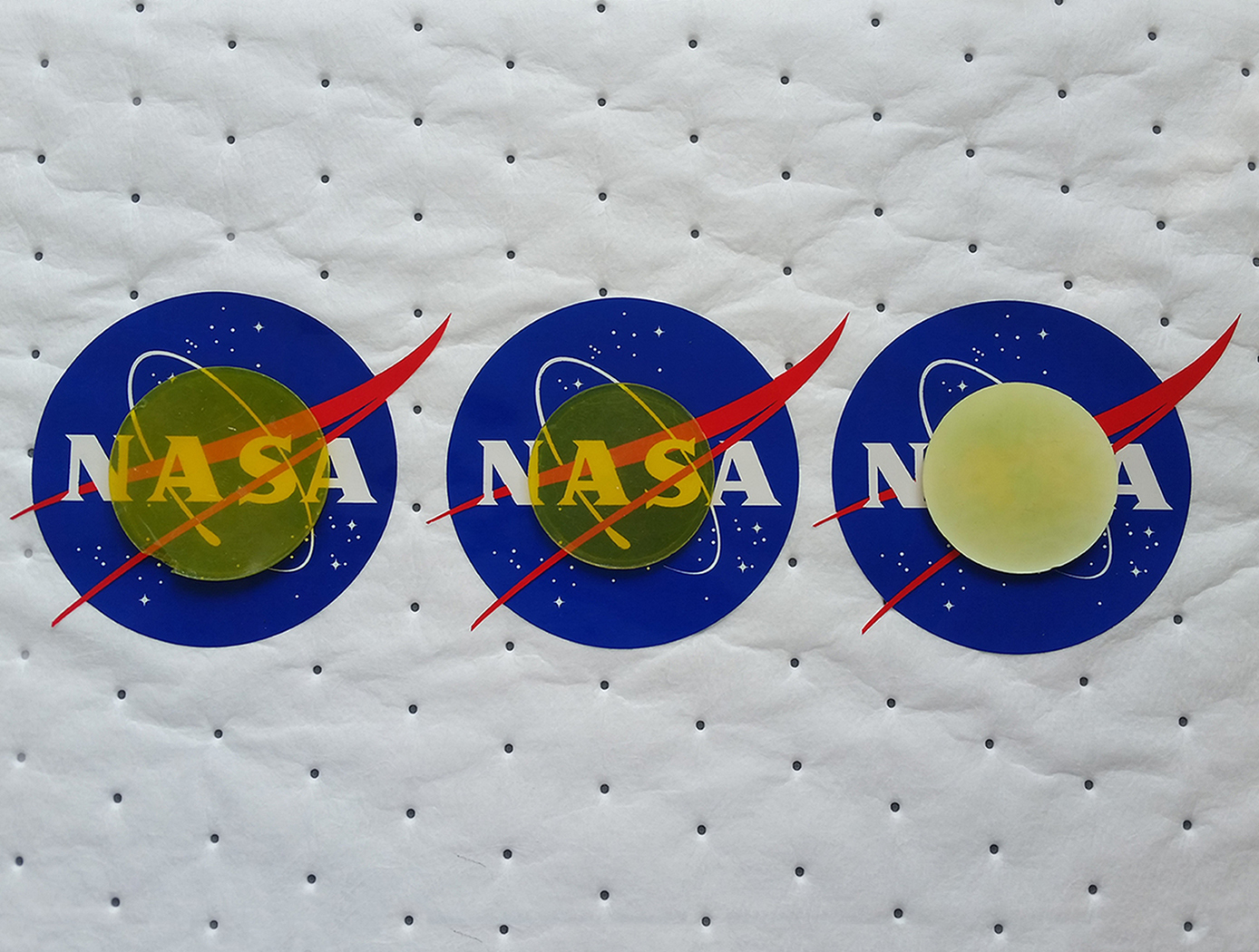Optically Transparent Polyimide Aerogels
materials and coatings
Optically Transparent Polyimide Aerogels (LEW-TOPS-117)
Highly porous aerogels with low thermal conductivity
Overview
Innovators at NASA's Glenn Research Center have expanded their growing portfolio of aerogels to include a new optically transparent polyimide aerogel. Aerogels - low density, highly porous, ultralight materials derived from gels - can be fabricated to achieve specific, desirable traits, including various ranges of optical transparency. In the past, high optical clarity was most commonly produced in silica aerogels, which shed dust particles and are notoriously fragile and brittle. In contrast, polyimide aerogels possess remarkable strength and flexibility. They are often used in aerospace applications due to their ability to retain their physical and mechanical properties in thermally and chemically demanding environments. Glenn's new polyimide aerogel maintains the robust nature of a polyimide network, while providing the added feature of extremely high surface areas and uniform pore size and distribution. This unique combination of strength, transparency, and exceptional insulating properties make these aerogels ideal for replacing windows, windshields, and more at a fraction of the weight and without the use of harmful or toxic chemical coatings.
The Technology
Innovators at NASA Glenn have devised a new method for harnessing the high transmission and clarity associated with optical glasses in a robust polyimide aerogel. This process uses sol-gel synthesis technology with aromatic dianhydrides and diamines as the precursors, and a trifunctional triacid chloride that arranges itself into a three-dimensional (3D) matrix with a low refractive index. The liquid portion of the gel is then removed by supercritical fluid extraction in order to produce the polyimide aerogel and maintain the desired 3D structure without pore collapse. The result is a cross-linked polyimide aerogel that allows for light wave transmittance while retaining low thermal conductivity. This unique material can be made into thin blocks, or highly flexible films as thin as 0.5 mm. While some embodiments have a yellow color, other embodiments may be nearly colorless. When compared to high-opacity polyimide aerogels, they have much greater surface area (up to 880 m2/g) and a very homogenous pore size (10 to 20 nm) with only a minor penalty in density (0.15 g/cc vs 0.10 g/cc). These strong, optically transparent aerogels incorporate a number of unique properties with applicability to a host of potential new applications, making this innovation a game-changer in the global aerogel market. Glenn welcomes co-development opportunities.


Benefits
- Optically transparent: With a refractive index close to 1, this aerogel technology has high optical transmission, low haze, and high optical clarity
- Low thermal and acoustic conductivity: These aerogels are ideal for advanced thermal and acoustic insulation applications
- Strong: A crosslinked polyimide skeletal structure, homogenous pore size and large surface area make these aerogels impact resistant and exceptionally strong
- Flexible and lightweight: Offers multiple levels of flexibility and can be crafted into thin, lightweight films
- Robust: Can retain physical and mechanical properties in thermally and chemically demanding environments
Applications
- Acoustic insulation (e.g. sound proofing)
- Aeronautics and aerospace (e.g. windshields, coatings)
- Antennas
- Architecture and construction (e.g. skylights, windows)
- Automotive
- Camping and exercise gear (e.g. water bottles, coolers)
- Optoelectronics (e.g. screen protectors)
- Optical sensors
- Protective clothing and gear
- Thermal insulation
Similar Results

Durable Polyimide Aerogels
Aerogels are highly porous, low-density solids with extremely small pore sizes, fabricated by forming a gel from a solution in the wet-gel state that is then converted to the dry-solid state without compaction of the porous architecture. Aerogels make excellent electrical, thermal, and acoustic insulators. However, most inorganic silica aerogels are fragile and shed dust. The NASA Glenn team is the first to synthesize three-dimensional polymer aerogel networks of polyimides cross-linked with multifunctional amine monomers. Compared to silica aerogels, these aerogels retain small pore sizes and low thermal conductivities, but are distinguished by their flexibility. Polyimide aerogels are not brittle, fragile, or dusty like silica aerogels. Plus, polyimide aerogels possess the beneficial characteristics and strength of polyimide materials. The results are cross-linked polyimide aerogels with little shrinkage, low densities, high compression and tensile strengths, and good moisture resistance. They can be fabricated or machined into net shape parts, which are strong and stiff, or cast as thin flexible films with good tensile properties. Extremely customizable, polyimide aerogels can be formed into any configuration (e.g., wrapped around a pipe, sewn into protective clothing, or molded into a panel to act as a heat shield in a car). In short, Glenn's innovation improves the performance, adaptability, and affordability of aerogels in a broad number of applications.

Polyamide Aerogels
Polyamides are polymers that are similar to polyimides (another polymer that has been developed for use in aerogels). However, because the amide link is a single chain while the imide link is a ring structure, polyamide aerogels can be made less stiff than polyimides, even though a similar fabrication process is used. The precursor materials can be made from any combination of diamine and diacid chloride. Furthermore, NASA Glenn researchers have found methods for using combinations of diamines and disecondary amines to produce polyamide aerogels with tunable glass transition temperatures, for greater control of features such as flexibility or water-resistance.
In the first step of the fabrication process, an oligomeric solution is produced that is stable and can be prepared and stored indefinitely as stock solutions prior to cross-linking. This unique feature allows for the preparation and transport of tailor-made polyamide solutions, which can later be turned into gels via the addition of a small amount of cross-linker. When the cross-linking agent is added, the solution can be cast in a variety of forms such as thin films and monoliths. To remove the solvent, one or more solvent exchanges can be performed, and then the gel is subjected to supercritical drying to form a polyamide aerogel. NASA Glenn's polyamide aerogels can be fully integrated with the fabrication techniques and products of polyimide aerogel fabrication, so hybrid materials which have the properties of both classes are easily prepared. As the first aerogels to be composed of cross-linked polyamides, these materials combine flexibility and transparency in a way that sets them apart from all other polymeric aerogels.

Polymer Cross-Linked Aerogels (X-Aerogels)
Researchers at NASA's Glenn Research Center have developed an approach to significantly improve the mechanical properties and durability of aerogels without adversely affecting their desirable properties. This approach involves coating conformally and cross-linking the individual skeletal aerogel nanoparticles with engineering polymers such as isocyanates, epoxies, polyimides, and polystyrene. The mechanism of cross-linking has been carefully investigated and is made possible by two reactions: a reaction between the cross-linker and the surface of the aerogel framework and a reaction propagated by the cross-linker with itself. By tailoring the aerogel surface chemistry, Glenn's approach accommodates a variety of different polymer cross-linkers, including isocyanates, acrylates, epoxies, polyimides, and polystyreneenabling customization for specific mission requirements. For example, polystyrene cross-linked aerogels are extremely hydrophobic, while polyimide versions can be used at higher temperatures. Recent work has led to the development of strong aerogels with better elastic properties, maintaining their shape even after repeated compression cycling. By tailoring the internal structure of the silica gels in combination with a polymer conformal coating, the aerogels may be dried at the ambient condition without supercritical fluid extraction.

Aerogel Reinforced Composites
GRC's aluminosilicate aerogel composites are fabricated using a sol-gel technique. A sol is formed by hydrolyzing an alumina dispersion in acid solution; the alumina may be combined with a silicon precursor to create a sol.
Fabrics, papers, and felts are used as reinforcing fibers to form an aerogel composite. The aerogel adheres to the reinforcement without use of sizing or organic binders. (In the case of sized fabrics, the sizing is first removed by heat cleaning.) Composites can be fabricated in a batch process, impregnating individual layers of paper, felt or fabric with the precursor sol, or in a roll-to-roll process. The sol is allowed to gel, and then aged for several days prior to supercritical drying using liquid CO2. Heat treatment of the super critically dried composites can be used to tailor the alumina or Aluminosilicate crystal structure and pore size.
In contrast to commercially available insulations, GRC's innovation provides extremely low thermal conductivity (60 mW/m-K at 900°C in argon) at high temperatures, thus enabling use at higher temperatures and improving applicability. In addition, GRC's unique process provides very good adhesion of the aerogel to its reinforcing fibers in alumina papers and zirconia felts, eliminating the spalling seen in other aerogel composites. Finally, GRC's innovation demonstrates low density and extreme resilience to high temperatures and harsh conditions. Seven layers of composite material of 1.25 mm/layer produced a temperature drop of 700°C when tested in the 8-foot high-temperature wind tunnel (8 HTT) at NASA's Langley Research Center. The technology also has withstood heat tests of up to 1200°C. In combination with other insulators, it has withstood fluxes of up to 65 W/cm2, producing a temperature drop of 625°C across 8 mm.

Self-Healing Low-Melt Polyimides
There are multiple space-related systems that can benefit from high performance, thin film, self-healing/sealing systems. Space vehicles and related ground support equipment can contain miles of wire, much of which is buried inside structures making it very difficult to access for inspection and repair. Space-based inflatable structures, solar panels, and astronauts performing extra-vehicular activities are subject to being struck by micrometeoroids and orbital debris. Self-healing or sealing layers on inflatables, solar panels and spacesuits would increase the safety and survivability of astronauts as well as the survivability and functionality of inflatables and solar panels. Self-healing insulation on wiring would greatly improve the reliability and safety of systems containing such wiring and reduce inspection and repair time over the lifetime of those systems. This technology combines the use of a self-sealing low melt, high performance polyimide film that exhibits the ability, when cut, for separated edges to slowly flow back together and seal itself, with the options of a laminate system and the inclusion of healant microcapsules that, when broken, release healant which can then additionally assist in the healing process. Combinations of the healing approaches can be enabling to the healing process proceeding at a much greater rate and dual mode healing approach can also allow for healing of a larger area.



